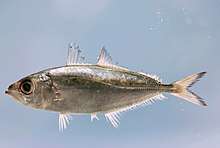Bigeye scad
The bigeye scad (Selar crumenophthalmus) is an oceanic fish found in tropical regions around the globe.[2] Other common names include purse-eyed scad, goggle-eyed scad, akule, chicharro, charrito ojón, jacks, matang baka, mushimas and coulirou.[2] The bigeye scad is fished commercially, both for human consumption and for bait.[3][4]
| Bigeye scad | |
|---|---|
 | |
| Scientific classification | |
| Kingdom: | Animalia |
| Phylum: | Chordata |
| Class: | Actinopterygii |
| Order: | Carangiformes |
| Family: | Carangidae |
| Genus: | Selar |
| Species: | S. crumenophthalmus |
| Binomial name | |
| Selar crumenophthalmus (Bloch, 1793) | |
| Synonyms | |
|
Scomber crumenophthalmus Bloch, 1793 | |
Description
The bigeye scad is blue-green or green on its back and sides and white on the underside. It grows to about 15 inches (38 cm) long and feeds on small invertebrates, fish larvae, and zooplankton. It is a schooling fish, it is mostly nocturnal, and it prefers clean, clear insular waters.
Uses
The bigeye scad are fished commercially; the global catches are about 200 thousand tonnes per year.[3] They are highly valued as food in Asian and Pacific cultures.[4] In Maldivian cuisine it is known as mushimas and commonly eaten in garudhiya or fried.[5] In Florida and the Caribbean they are popular as bait.[4]
.tif.jpg)
Parasites
Parasites of the bigeye scad include the philometrid nematode Philometra selaris, which lives inside the ovary of the females.[6]
References
- Smith-Vaniz, W.F.; Williams, J.T.; Brown, J.; Curtis, M. & Pina Amargos, F. (2015). "Selar crumenophthalmus (errata version published in 2017)". IUCN Red List of Threatened Species. 2015: e.T190388A115316971. doi:10.2305/IUCN.UK.2015-4.RLTS.T190388A16510647.en.{{cite iucn}}: error: |doi= / |page= mismatch (help)
- Froese, Rainer and Pauly, Daniel, eds. (2014). "Selar crumenophthalmus" in FishBase. August 2014 version.
- "Selar crumenophthalmus (Bloch, 1793)". FAO Species Fact Sheets. FAO Fisheries and Aquaculture Department. 2015. Retrieved 6 January 2015.
- Welch, A.; Hoenig, R.; Stieglitz, J.; Daugherty, Z.; Sardenberg, B.; Miralao, S.; Farkas, D.; Benetti, D. (2013). "Growth rates of larval and juvenile bigeye scad Selar crumenophthalmus in captivity". SpringerPlus. 2: 634. doi:10.1186/2193-1801-2-634. PMC 3856327. PMID 24324928.
- Xavier Romero-Frias, The Maldive Islanders, A Study of the Popular Culture of an Ancient Ocean Kingdom, Barcelona 1999, ISBN 84-7254-801-5
- Moravec, František; Justine, Jean-Lou (2014). "Philometrids (Nematoda: Philometridae) in carangid and serranid fishes off New Caledonia, including three new species". Parasite. 21: 21. doi:10.1051/parasite/2014022. ISSN 1776-1042. PMC 4023622. PMID 24836940.

External links
| Wikimedia Commons has media related to Selar crumenophthalmus. |
- "Selar crumenophthalmus". Integrated Taxonomic Information System. Retrieved 12 June 2006.
- Australian Museum Fish Site species page
- Guam Department of Agriculture's Division of Aquatic & Wildlife Resources species page
- Bigeye scad stock video footage
- University of Rhode Island page with sound files of bigeye scads producing grating sounds with their teeth
- Photos of Bigeye scad on Sealife Collection
